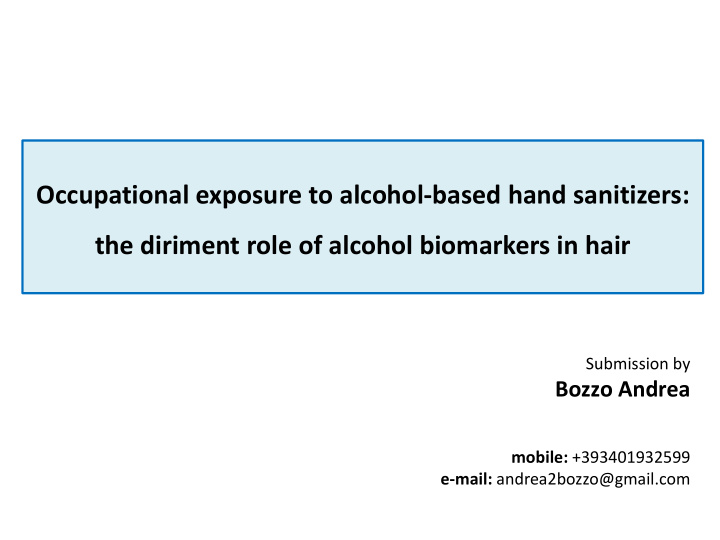



Occupational exposure to alcohol-based hand sanitizers: the diriment role of alcohol biomarkers in hair Submission by Bozzo Andrea mobile: +393401932599 e-mail: andrea2bozzo@gmail.com
Introduction The direct determinations of alcohol in blood and exhaled breath represent the most common analyses used to ascertain recent ethanol consumption in forensic cases, but they do not provide any clue about the possible incidence of chronic alcohol abuse. In recent years, the detection of direct ethanol biomarkers in unconventional ( keratin ) matrices has become very popular in clinical and toxicological diagnostics, in order to discover either chronic alcohol abuse or abstinence. In particular, Ethylglucuronide (EtG) is a direct biomarker with high sensitivity and diagnostic specificity, and represents an indicator of alcohol intake in the short (serum), medium (urine), and long term (keratin matrix). Ethanol is also a compound widely spread in the workplaces (clinics, hospitals, etc.) and it is present in considerable amounts in mouthwash for oral cleaning, medications, cosmetic products, hydro-alcoholic disinfectants and antiseptics for hands . Currently, in hospitals and healthcare facilities the hand hygiene by alcohol-based formulations are among the most effective action for disinfection and to reduce the infections. So surgeons and healthcare assistants are potentially exposed to ethanol absorption several times per day, through both the skin and the respiratory tract. Positive findings of blood ethanol and urinary EtG have been reported after sustained exposure to ethanol-based hand sanitizers in literature.
Purpose Aim of the present study was to verify if the daily exposure to ethanol- containing hygiene products may induce significant concentrations of alcohol markers (namely EtG and FAEE above the SoHT-recommended cut- offs), especially in conditions of total abstinence from ethanol-containing beverages. Ethylglucuronide (EtG ) and Fatty Acid Ethyl Esters (FAEEs) in hair are effective direct biomarkers of ethanol ingestion, whose analytical determination can be used to discriminate between chronic and occasional ethanol intake.
Experimental and Method Two types of hand disinfectants (ethanol 62% w/w) were daily applied on the hands of a teetotaler for 20 times a day , for 4 consecutive weeks (a cumulative dermal exposure to ethanol of 1100 grams ). Different matrices (head, chest and beard hair, urine) were regularly sampled from a volunteer and analyzed using a UHPLC-MS/MS validated method for ethyl glucuronide and a (HS)SPME-GC-MS validated technique for FAEEs. Peculiarities of the Study are: • no scientific research has ever tested the EtG and the FAEEs in keratin matrices with the purpose of assessing the exposure to ethanol content in disinfectants; • never exposure to hydro-alcoholic disinfectants for such a long period : a month (chronic exposure); • the Study Protocol was applied in a reliable and highly controlled way during the whole month and some rigid exclusion criteria were taken into account for participation at the study (total abstention from drinking and no use of other ethanol- based products, etc.)
Results The twenty urine samples taken every day in the morning (9.30 am) were negative to EtG (<LOQ) while the samples collected at the end of the working day (i.e. 5.30 pm, after 20 applications) contained measurable amounts of EtG . The EtG-u concentrations and the relative values normalized with respect to the creatinine concentration are reported in Table . The intensive use of ethanol-containing hand disinfectants came out values greater than clinical and forensic cut-off, just like after the intake of alcoholic beverages. The EtG analysis in keratin matrices produced a negative outcome relative to the intake of alcohol. The EtG results in beard, chest and head hair were consistently below the LOQ of the method (7 pg/mg), namely lower than the cut-off values normally chosen for abstinence assessment (7 pg/mg) and much lower than that used to ascertain chronic alcohol abuse (30 pg/mg). Also the concentrations of FAAEs in head and beard hairs were all far below 0.5 ng/mg (0.35 ng/mg for ethyl palmitate), namely the cut-off values used to verify the occurrence of chronic alcohol abuse.
Conclusions The data obtained showed that the use of detergents produce urinary EtG concentrations both higher than the clinical and forensic cut-offs (100 and 500 ng/mL respectively). The concentrations of the ethanol metabolites in the keratin matrices were respectively below the cut- off of 10 pg/mg for EtG and below 0.5 ng/mg for FAAEs (0.35 ng/mg for ethyl palmitate) and therefore were not affected by use of disinfectants containing ethanol. The excessive use of alcohol-based hand sanitizers can affect the concentration of urinary EtG (positive results), but the direct biomarkers of alcohol abuse in the keratin matrix are capable of distinguishing between ethanol consumption and incidental exposures. This type of result is particularly significant for the professions that make use of hand sanitizers frequently, (i.e., several times per day) and undergo regular workplace alcohol testing, a typical condition occurring for surgeons and healthcare assistants . Such a risk of false positive result should always be taken into consideration when urinary EtG is used as a marker of ethanol consumption. In conclusion, the use and daily application of hydro-alcoholic gel for hand hygiene can lead to positive results in the analysis of urinary EtG, but cannot increase the EtG and FAEEs levels in the keratin matrix. The analysis of urinary EtG should always be combined with hair EtG (and hair FAEEs) in order to carry out an accurate diagnosis of alcohol abuse or abstinence, in particular in workplace situations. Thanks for your attention
Recommend
More recommend